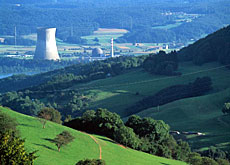
Power giant warns of coming “energy crunch”

Switzerland’s largest electricity company Axpo says it has to act now to prevent a serious "energy crunch" that could develop over the next decade.
The firm unveiled proposals at a news conference to invest more than SFr5 billion ($4 billion) in measures including the construction of new gas-fired power plants – and tentative longer-term plans for a new nuclear plant.
The announcement comes shortly after the head of the federal energy office, Walter Steinmann, said he favoured building gas-fired plants to meet future demand, although that would increase emissions of carbon dioxide, the main “greenhouse gas” commonly held responsible for global warming.
Axpo CEO Heinz Karrer stressed that building new nuclear plants was “not a priority” and said no decisions had yet been made regarding timing, cost, location or overall feasibility.
He told swissinfo that a decision to proceed with a feasibility study could be taken around 2008, and that the complete planning process – including approval and construction – could take as long as 20 years.
“Axpo will need to begin filling the emerging gap for baseload electricity [the minimum amount of power demand for which supplies must be guaranteed round the clock] by 2018.
“Time constraints mean that it will not be possible to do this with a new domestic nuclear plant,” Karrer said.
Pros and cons
Construction of new gas plants would be part of a wider package of investment measures totalling more than SFr5 billion, aimed at averting an energy supply crunch by 2020.
This would comprise some SFr2 billion to optimise existing hydropower plants, a further SFr2 billion to build new thermal – gas-fired – plants, SFr1 billion to expand the distribution network, and at least SFr100 million within the next five years on promoting renewable energy forms.
Karrer said that, in addition to relatively short planning and construction periods (compared to nuclear), combined cycle gas plants also offered the advantage of very high operational efficiency levels.
However, in addition to emitting CO2, they were “highly dependent” on world gas prices, which would “presumably” increase in the longer term, as well as on fuel supplies from other countries.
Nuclear plants, by contrast, offered “cheap and stable” prices, very low fuel costs and dependency and produced no CO2 during operation.
However, he added: “The question of public acceptance of a new nuclear plant is a critical factor, and the long time horizon poses a risk that should not be underestimated from a business planning perspective.”
Axpo plans to begin a feasibility study for construction of a combined-cycle gas plant “within the next few months”, and estimates that the planning and construction process could be completed within seven to nine years.
Potential crisis
According to Karrer, the Swiss energy supply situation could become acute after 2020, if the country’s two oldest nuclear plants close down and supply contracts with French nuclear plants are not renewed.
He estimated that, if no action was taken to replace existing capacity and import contracts, the supply gap could reach between 10 and 30 terawatt-hours (TWh) by 2030 – between 15 and 33 per cent of total anticipated annual demand.
This situation – which mirrored a similar looming crisis at Europe-wide level – could be particularly serious during winter months, when a supply gap could begin arising as early as 2012.
And Karrer added that options were limited – energy efficiency and conservation measures were not even capable of keeping pace with annual demand growth, new renewable energy sources were “nowhere near” being able to meet the gap, and the potential to expand Swiss hydro-power capacity was “very limited”.
Switzerland currently produces some 40 per cent of its electricity from five nuclear power plants and the vast majority of the rest from hydropower.
The issue is also complicated by the fact that the other main existing option – gas or coal-fired plants – produce significant quantities of carbon dioxide.
Decision time
Karrer said Axpo would have to make initial decisions regarding new baseload electricity supply capacity after 2020 by 2008 at the latest.
He added: “Unfortunately, baseload electricity can only be provided by renewable energy to a very limited extent.
“This is a very important factor, which [many people] either do not understand or do not want to acknowledge.”
In a reaction, Greenpeace said the plan was irresponsible and short-termist.
“Atomic energy is out of date and a pollutant,” said the ecological organisation. “It has no place in a renewable energy scenario.”
swissinfo, Chris Lewis in Zurich
Total Swiss electricity production in 2004 was 63.5 TWh, of which hydropower accounted for 55% and nuclear for 40%.
The Swiss power industry, while part of the European network, is largely self-sufficient.
However, Switzerland is a major trading centre, with annual electricity imports and exports often totalling up to ten times the European average.

In compliance with the JTI standards
More: SWI swissinfo.ch certified by the Journalism Trust Initiative




























You can find an overview of ongoing debates with our journalists here . Please join us!
If you want to start a conversation about a topic raised in this article or want to report factual errors, email us at english@swissinfo.ch.